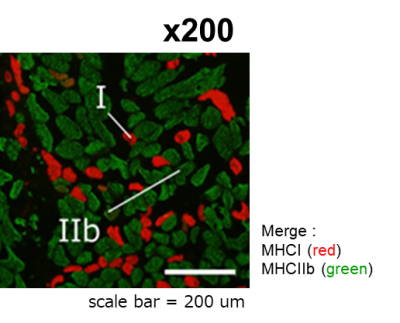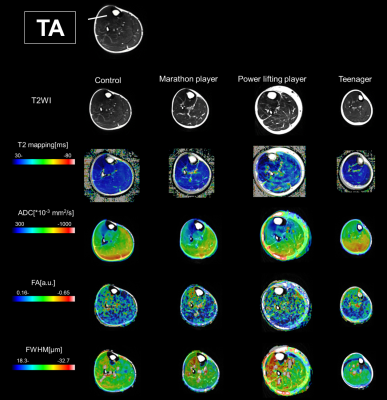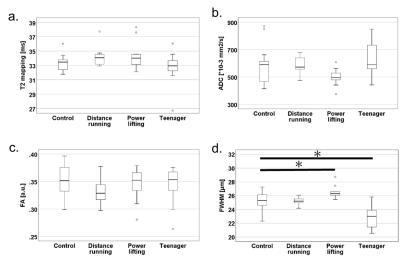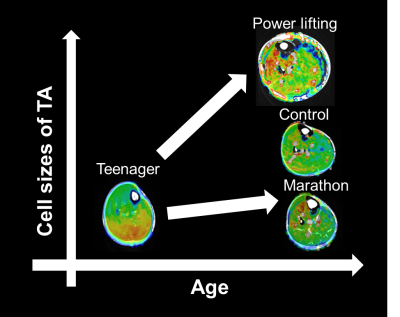2704
The visualization technique of the distribution of muscle quality by sport characteristics / changes due to growth using q-space imaging1Keio University School of Medicine, Tokyo, Japan, 2Jikei University School of Medicine, Tokyo, Japan
Synopsis
We evaluated the muscle quality of lower limbs among four groups: controls, marathon players, powerlifters, and teenagers using q-space imaging. Initially, we confirmed that fast muscle fiber has a larger cell size than slow muscle fiber in cadaveric immunohistology study of the tibialis anterior muscle (TA). In addition, there were many fast muscle fiber in the TA. In q-space imaging study, the cell diameter increased in the process of growing up from teenage to adulthood, which indicates an increase in fast muscle cells according to growth. Furthermore, the powerlifting players had more enlarged fast muscle cells than other groups.
INTRODUCTION
In the human body, skeletal muscles consist of fast muscle fibers and slow muscle fibers. There is no non-invasive approach for investigating the characteristics of these muscles. The tibialis anterior muscle (TA) and soleus muscle (SOL) of the calf have been widely used in physiological and pathological studies in animals and humans 2. The TA is mainly composed of fast fibers, while the SOL is mainly composed of slow fibers 1. The types of muscle fibers are based on the myosin heavy chain (MHC) isoform compartment and include 1 slow type (MHC I) and multiple fast types (MHC IIa, MHC IIb, MHC IId, and MHC IIx) . Monitoring of skeletal muscle characteristics can help in evaluation of the effects of strength training on skeletal muscles. q-space imaging (qsi) is a quantitative diffusion-weighted imaging (DWI) procedure that makes it possible to detect delicate changes in the microstructure of environments in which free water movement is restricted 2. Previously, we showed that fast muscles and slow muscles can be separated in animal experiments 3 and clinical studies 4 using qsi. The present study aimed to determine whether qsi can distinguish muscle quality by age/sports characteristics.METHODS
We acquired MRIs in 40 volunteers [control (average 34.5±5.1 y.o.), marathon players (average 24.2±3.1 y.o.), powerlifting players (average 29.8±3.4 y.o.), and teenager (17.2±0.9 y.o.): each n = 10] using a 3-Tesla MRI (MAGNETOM Skyra system, Siemens Healthcare, Erlangen, Germany) and human cadaveric immunohistology on TAs. T2 weighted imaging (T2WI), T2 mapping [ms] and qsi were performed with a field of view of 275 mm × 400 mm and section thickness of 6 mm. b-values had diffusion encoding in six directions. The detailed protocol is described in Figure 1. The qsi parameter; i.e., a full width at half maximum (FWHM) map, was obtained by averaging the values obtained in the six directions. In addition, the apparent diffusion coefficient (ADC) [10-3 mm2/s] and fractional anisotropy (FA) [arbitrary unit: a.u.] map calculated by diffusion tensor imaging (DTI) were composed using b800 images of qsi. The differences in the values for TA among four groups (controls, marathon players, powerlifting players, and teenagers) were examined using T2 mapping, ADC, FA and FWHM maps. Regarding the human cadaveric immunohistology on TA, by staining MHC type I in red and MHC type IIb in green, we examined the differences in the cell diameters of the slow/fast fibers.RESULTS
In human cadaveric immunohistology studies on the TA, MHC type IIb cells have a larger cell size than MHC type I cells (Figure 2). It was the same result as in animal experiments, which we performed previously 3. In a study using MRI, T2WI, T2 mapping, ADC, and FA maps could not represent the differences among the four groups (Figures 3 and 4). On the other hand, a FWHM map could visualize the differences in the TA between controls and powerlifting players and the difference in the TA between the control adults and teenagers (p<0.05; Figure 3 and 4).DISCUSSION
In human cadaveric immunohistology studies on the TA, the fast muscle cells were larger than the slow muscle cells, and the possibility that the cells could be distinguished by observing the cell diameter was shown. In MRI studies, the cell diameter increased in the process of growing up from teenage to adulthood and, among them, the powerlifter had more enlarged fast muscle cells (Figure 5). There is a possibility that changes in cell types due to growth and sports competition characteristics could be captured by qsi. This technique is a promising method that can be used to non-invasively estimate the fiber type ratio in skeletal muscles.SIGNIFICANCE
This technique is a promising method that can be used to non-invasively estimate the fiber type ratio in skeletal muscles, and it can be further developed as an indicator of muscle characteristics.Acknowledgements
We are grateful to Masato Suzuki, Yoshifumi Sone for the technical assistance.References
1: Punkt, K. Acta Histochem. (1998). 2: Callaghan, P. T. Nature (1991). 3: Hata. J. PLoS One (2019). 4: Nakashima. D. ISMRM (2019). 5 Delp, M. Appl. Physiol. (1996)Figures


Representative figure of the TA obtained from a human cadaveric calf.
MHC type IIb cells (green: fast fiber) have larger cell sizes than MHC type I cells (red: slow fiber).

Comparison of TAs in calf MRIs
T2WI, T2 mapping, ADC, and FA maps could not represent the differences among the four groups. FWHM map could visualize the differences in the TA between controls and powerlifting players and the difference in the TA between the control adults and teenagers.

Quantitative comparison of MRI findings in the TA.
*P<0.05 (Dunnett test; reference = Control) The end of the whisker represents the standard deviation. FWHM could distinguish the difference between adult control and powerlifter group and the difference between adult control and teenager group.

Schematic of the change in cell sizes of the TA.
Muscle fiber size varies with growth and sporting characteristics.